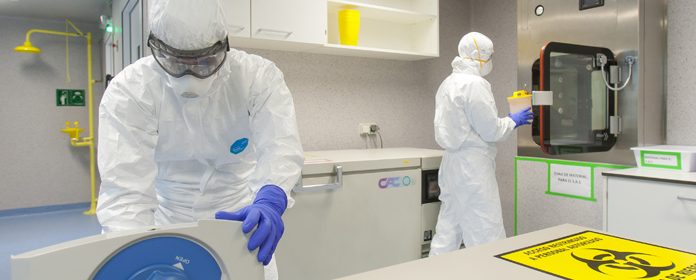A new biosafety 3 laboratory to improve vaccines and design new diagnostic techniques
Located at the University of Navarra and co-funded by the Government of Navarra, it will study the pathogens that cause brucellosis, leishmaniasis, dysentery and other serious diseases.

The department of Microbiology of the University of Navarra has a new biosafety laboratory 3 where research will be carried out on the improvement of vaccines and the design of new diagnostic and treatment techniques.
The facilities - financed by the University itself and by the Government of Navarra - will work on pathogenic microorganisms that cause diseases such as brucellosis, leishmaniasis or bacterial dysentery, among others. "These are microorganisms that cause diseases with a great impact on human and animal health. Our goal with these new facilities is to develop projects that allow us to provide new tools for their control", emphasizes the director of the department of Microbiology, Professor Carlos Gamazo.
This is the case with brucellosis, one of the most widespread zoonoses in the world. "Although it mainly affects cows, pigs, goats and sheep, it can also be transmitted to humans, causing a very debilitating chronic disease that requires long and costly antibiotic treatment. This makes it a public health and economic problem, especially serious in developing countries development", details one of the researchers of department, Raquel Conde.
For his part, Paul Nguewa, director of ISTUN (high school of Tropical Health of the University of Navarra) and coordinator of the work on leishmaniasis, recalls that there are 300 million people in the world at risk of contracting it: "At ISTUN we are working on the search for vaccines and the generation of better systems for diagnosis and treatment, all of which are objectives set by the WHO for the control of this parasitosis".
At laboratory biosafety 3, several projects will also be developed aimed at design for effective vaccines against bacterial dysentery, "an ailment manager responsible for the death of 280,000 people a year, mostly children. To date, no vaccine has been approved by the regulatory agencies, which is why the WHO has declared research on vaccines against these pathogens to be a priority," Dr. Gamazo explains.
Security levels: 1 to 4research laboratories can have up to 4 levels of security. Those that fall into level 3 have specific facilities and very secure work protocols. "Access is restricted to staff who have received prior training to work in them. Appropriate protective clothing must be worn and pathogens are handled in safety cabinets. All this is done in a negative pressure enclosure that prevents the escape of microorganisms to the outside. In addition, all material leaving the facilities is previously inactivated," specifies Dr. Conde.
"training andinformation must go hand in hand on biosafety issues, in order to avoid the unintentional exhibition of biological material or its accidental release. All persons working in the facility should have a thorough knowledge of the work and safety protocols. In the event of an emergency, very precise action protocols verified by the National Biosafety Agency would be applied at laboratory , including alarm systems and equipment to disinfect conference room if necessary, since biosafety is a priority," concludes director, Carlos Gamazo.
The projects that will be carried out in the new laboratory are integrated in the high school de research Sanitaria de Navarra (IdiSNA), research center of excellence, recently accredited by the Ministry of Science, Innovation and Universities.
Video of the new 3D installations
